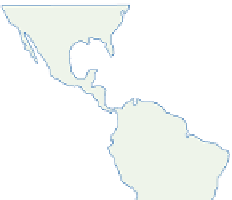Geoscience Reference
In-Depth Information
and maximum wind speeds near the core were in
excess of 55m s
-1
. More than 500mm of rain fell
on the highest parts of Jamaica in only nine hours.
However, the most striking feature of this record
storm was its size, being some three times that of
average Caribbean hurricanes. At its maximum
extent, the hurricane had a diameter of 3500km,
disrupting the ITCZ along more than one-sixth of
the earth's equatorial circumference and drawing
in air from as far away as Florida and the
Galapagos Islands.
The main tropical cyclone activity in both
hemispheres is in late summer to autumn during
times of maximum northward and southward
shifts of the Equatorial Trough (
Table 11.1, Plate
11.3
). A few storms affect both the western North
Atlantic and North Pacific areas as early as May
and as late as December, and have occurred
during every month in the latter area. In the Bay
of Bengal there is also a secondary early summer
maximum. Floods from a tropical cyclone that
struck coastal Bangladesh on 24-30 April 1991
caused over 130,000 deaths from drowning and
left over ten million people homeless. The annual
frequency of cyclones shown in
Table 11.1
is only
approximate, since in some cases it is uncertain
whether the winds actually exceeded hurricane
force. In addition, storms in the more remote
parts of the South Pacific and Indian Oceans
frequently escaped detection prior to the use of
weather satellites. A 270-year proxy record of
North Atlantic hurricanes suggests a decrease in
frequency from the 1760s to early 1990s with
anomalously low values in the 1970s-1980s. The
enhanced activity since 1995 represents a return
to more normal conditions.
A number of conditions are necessary, even if
not always sufficient, for cyclone formation. One
requirement as shown by
Figure 11.8
is an
extensive ocean area with a surface temperature
greater than 27
C. Cyclones rarely form near the
equator, where the Coriolis parameter is close to
zero, or in zones of strong vertical wind shear (
i.e.,
beneath a jet stream), as both factors inhibit the
development of an organized vortex. There is also
a definite connection between the seasonal
position of the Equatorial Trough and zones of
cyclone formation. This is borne out by the fact
that only one cyclone has occurred in the South
Atlantic (where the trough never lies south of 5
°
S)
and none in the southeast Pacific (where the
trough remains north of the equator). However,
the northeast Pacific has an unexpected number
of cyclonic vortices in summer. Many of these
move westward near the trough line at about
10-15
°
N. About 60 percent of tropical cyclones
seem to originate 5-10
°
latitude poleward of the
Equatorial Trough in the doldrum sectors, where
the trough is at least 5
°
latitude from the equator.
The development regions of cyclones lie mainly
°
1
Cancer
30
30
Eq
uator
1
5
20
Sea surface temperature >27°C in warmest month
Hurricane tracks
Frequency of Hurricane Genesis (20-year period)
Capricorn
10
Figure 11.8
Frequency of hurricane genesis (numbered isopleths) for a 20-year period. The principal hurricane
tracks and the areas of sea surface having water temperatures greater than 27°C in the warmest month are also
shown.
Source: After Palmén (1948) and Gray (1979).

























































































































